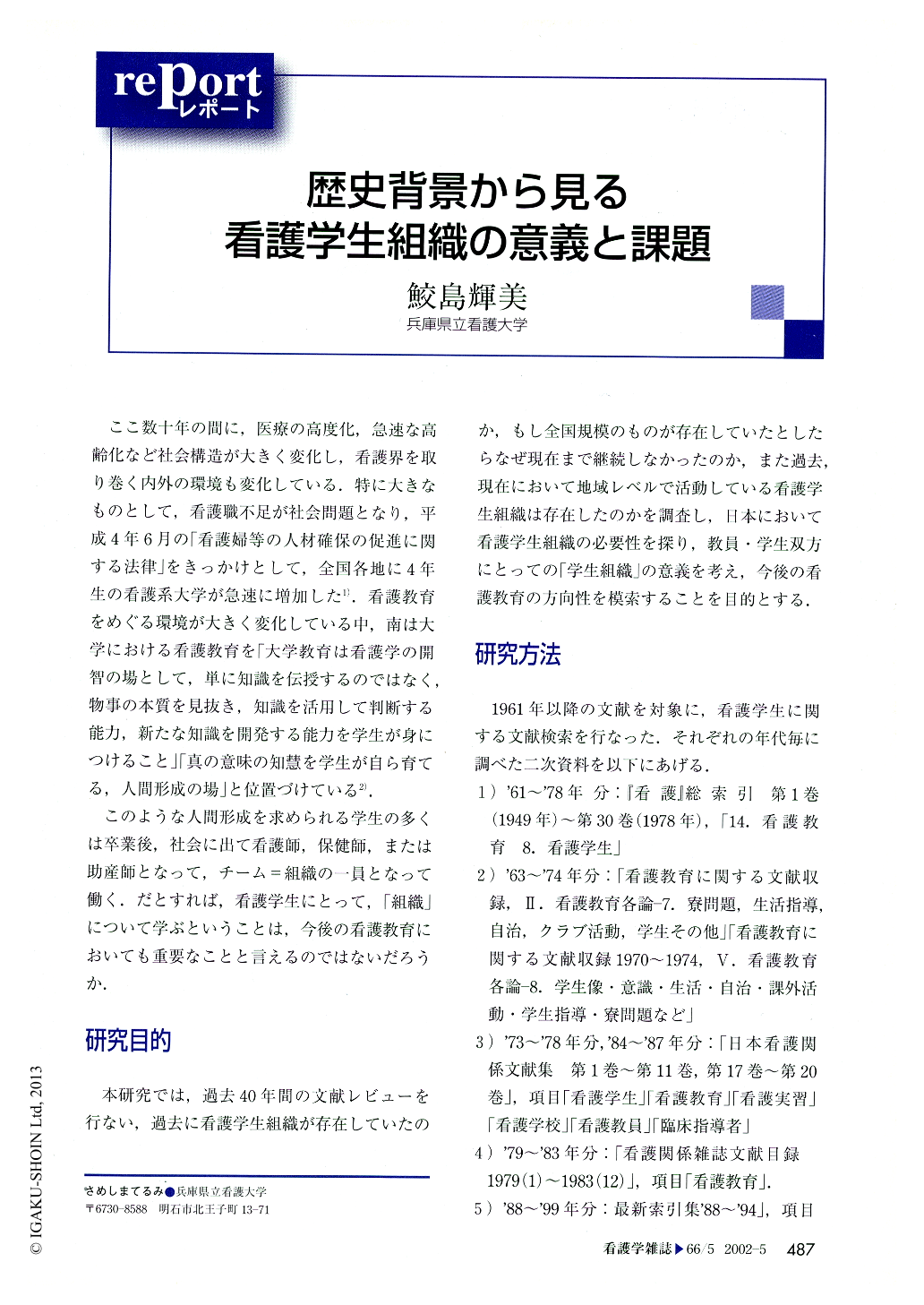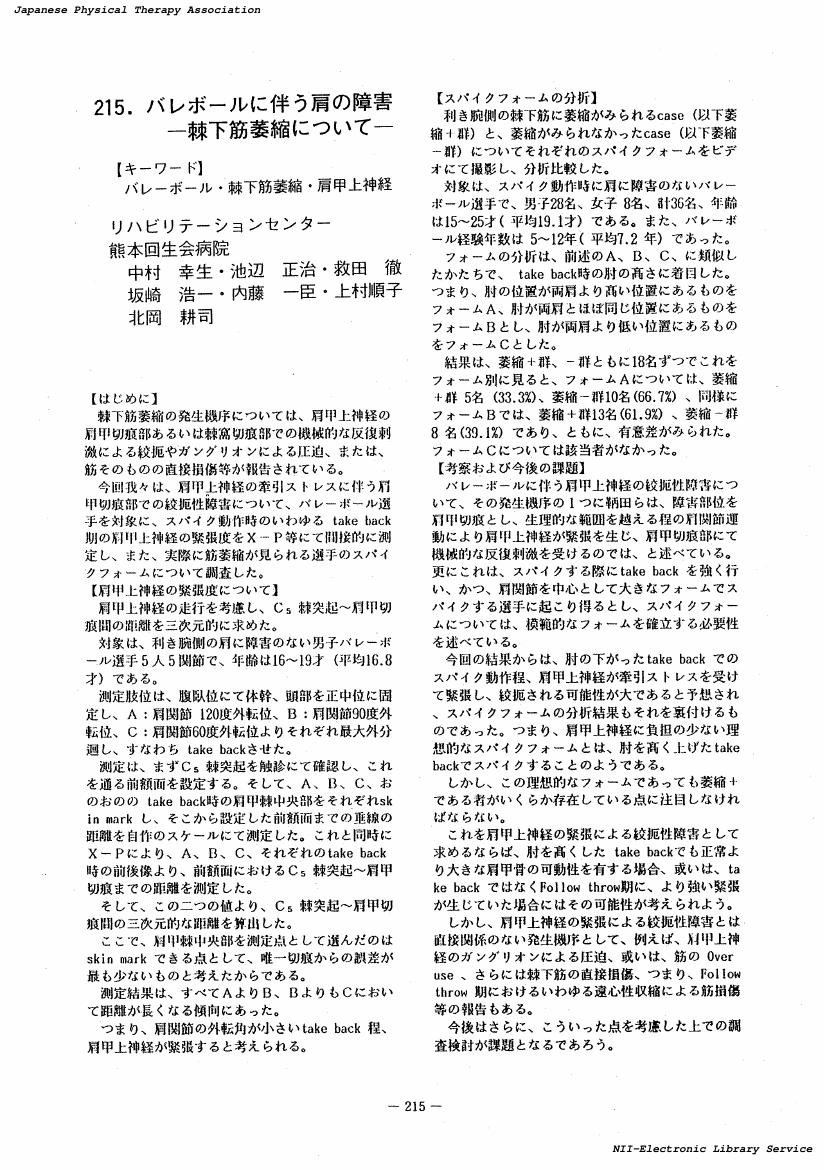- 著者
- 下村 満子
- 出版者
- インテリジェンス出版社
- 雑誌
- ビジネス・インテリジェンス
- 巻号頁・発行日
- vol.19, no.4, pp.10-12, 2005-04
1 0 0 0 集団現実性と外集団の道徳性認知が非当事者攻撃に与える効果
- 著者
- 熊谷 智博
- 出版者
- 大妻女子大学
- 雑誌
- コミュニケーション文化論集 : 大妻女子大学コミュニケーション文化学会機関誌 (ISSN:13479423)
- 巻号頁・発行日
- no.13, pp.29-41, 2015-03
1 0 0 0 OA わが国における硬膜動静脈瘻の治療の現状(<特集>脳脊髄動静脈奇形の診断・治療の進歩)
- 著者
- 桑山 直也 久保 道也 遠藤 俊郎 坂井 信幸
- 出版者
- 日本脳神経外科コングレス
- 雑誌
- 脳神経外科ジャーナル (ISSN:0917950X)
- 巻号頁・発行日
- vol.20, no.1, pp.12-19, 2011-01-20 (Released:2017-06-02)
- 参考文献数
- 8
- 被引用文献数
- 29 25
硬膜動静脈瘻の治療の現状を知るため,全国の脳血管内治療専門医を対象とする調査を実施した.【方法】日本脳神経血管内治療学会専門医388人を対象とし,2005〜2006年の2年間に経験した症例の年齢/性,部位,症状,mRS,治療法,転帰,合併症を調査した.【結果】863症例の回答を得た.男性43%,女性54%,平均年齢は64歳であった.海綿静脈洞(CS)が46%,横・S状静脈洞(TSS)27%,その他27%であった.814例に積極的治療(血管内88%,外科7%,放射線4%)が施行された.治療後(ほぼ)完全閉塞が83%であった.mRSは1.4から0.6に改善した.治療合併症が4%に出た.【まとめ】CS,TSSの成績は良好であった.前頭蓋底,頭蓋脊椎移行部では安易な血管内治療が行われている可能性があり,外科治療を再評価すべきと思われた.
1 0 0 0 OA 両側視床病変を呈した硬膜動静脈瘻の1例
- 著者
- 山本 隆広 渡邉 聖樹 三浦 彰子 平原 智雄 平野 照之 内野 誠
- 出版者
- 日本神経学会
- 雑誌
- 臨床神経学 (ISSN:0009918X)
- 巻号頁・発行日
- vol.50, no.10, pp.718-724, 2010 (Released:2010-11-04)
- 参考文献数
- 26
- 被引用文献数
- 4 6
症例は51歳の男性である.2カ月前より頭痛,活動性の低下,見当識障害が徐々に進行し当科入院した.頭部MRI T2強調画像にて両側視床に高信号域をみとめ,左傍中脳に静脈の拡張と思われるflow voidをみとめた.脳血管造影にて,左上錐体静脈洞部に硬膜動静脈瘻をみとめた.流入動脈は内頸動脈が中心であり,流出静脈は深部静脈系へ逆流していた.このため両側視床の灌流障害をきたしていると考えられた.主な流入血管に対し経動脈的塞栓術を施行したところ見当識障害と視床病変の改善がえられた.硬膜動静脈瘻は両側視床病変の原因となることもあり,治療介入で改善が期待できるため,早期診断が望ましい疾患である.
1 0 0 0 OA 治療過程で視床性痴呆を呈した硬膜動静脈瘻の1例
- 著者
- 金中 直輔 佐藤 博明 阿部 肇 根城 尭英 福井 敦 寺西 裕 鳥橋 考一 宮腰 明典 楚良 繁雄 河野 道宏
- 出版者
- 一般社団法人 日本脳卒中学会
- 雑誌
- 脳卒中 (ISSN:09120726)
- 巻号頁・発行日
- vol.35, no.3, pp.203-208, 2013-05-20 (Released:2013-05-24)
- 参考文献数
- 5
要旨:頭痛を主訴に来院した68歳男性.3年間にわたる硬膜動静脈瘻の治療経過において,頭部CTやMRIのFLAIRおよびT2画像にて両側視床に限局した異常信号域を認めた.深部静脈系のvenous congestionによるvenous hypertensionが疑われた.臨床症状として特徴的な視床性認知症を呈していたが,血管内治療により画像的にも臨床的にも改善を認めた.このような適確な診断と治療により可逆的な病態である一方で,時期を逸することで不可逆的な変化を来すこともありうるため,迅速かつ適確な対応が必要な疾患であると考えられた.
1 0 0 0 IR ゲイカップルの親密性と生活に関する研究 : クィア家族研究と後期近代社会論の視座
1 0 0 0 OA 酒類と金属
- 著者
- 戸塚 昭
- 出版者
- 公益社団法人 日本農芸化学会
- 雑誌
- 化学と生物 (ISSN:0453073X)
- 巻号頁・発行日
- vol.13, no.4, pp.229-234, 1975-04-25 (Released:2009-05-25)
- 参考文献数
- 9
1 0 0 0 京都天然砥石の魅力
- 著者
- 京都天然砥石組合記念誌編集委員会編
- 出版者
- 京都天然砥石組合
- 巻号頁・発行日
- 1993
1 0 0 0 冤罪はこうして作られる
1 0 0 0 大学生のためのレポート・論文術
1 0 0 0 歴史背景から見る看護学生組織の意義と課題
- 著者
- 鮫島 輝美
- 出版者
- 医学書院
- 雑誌
- 看護学雑誌 (ISSN:03869830)
- 巻号頁・発行日
- vol.66, no.5, pp.487-493, 2002-05-01
ここ数十年の間に,医療の高度化,急速な高齢化など社会構造が大きく変化し,看護界を取り巻く内外の環境も変化している.特に大きなものとして,看護職不足が社会問題となり,平成4年6月の「看護婦等の人材確保の促進に関する法律」をきっかけとして,全国各地に4年生の看護系大学が急速に増加した1).看護教育をめぐる環境が大きく変化している中,南は大学における看護教育を「大学教育は看護学の開智の場として,単に知識を伝授するのではなく,物事の本質を見抜き,知識を活用して判断する能力,新たな知識を開発する能力を学生が身につけること」「真の意味の知慧を学生が自ら育てる,人間形成の場」と位置づけている2). このような人間形成を求められる学生の多くは卒業後,社会に出て看護師,保健師,または助産師となって,チーム=組織の一員となって働く.だとすれば,看護学生にとって,「組織」について学ぶということは,今後の看護教育においても重要なことと言えるのではないだろうか.
1 0 0 0 OA 215. バレーボールに伴う肩の障害 : 棘下筋萎縮について
- 著者
- 中村 幸生 池辺 正治 救田 徹 坂崎 浩一 内藤 一臣 上村 順子 北岡 耕司
- 出版者
- 公益社団法人 日本理学療法士協会
- 雑誌
- 理学療法学Supplement Vol.16 Suppl. (第24回日本理学療法士学会誌 第16巻学会特別号)
- 巻号頁・発行日
- pp.215, 1989-03-31 (Released:2017-07-07)
1 0 0 0 OA 高齢者の認知・精神機能と転倒リスク
- 著者
- 牧迫 飛雄馬
- 出版者
- 日本転倒予防学会
- 雑誌
- 日本転倒予防学会誌 (ISSN:21885702)
- 巻号頁・発行日
- vol.3, no.3, pp.5-10, 2017-03-10 (Released:2017-09-25)
- 参考文献数
- 37
- 被引用文献数
- 2
フレイルは,身体的な問題のみならず,認知機能障害やうつなどの精神・心理的問題,さらに独居や経済的困窮などの社会的問題を含む概念とされ,転倒リスクの把握のためにも,身体機能のみならず,認知機能や精神機能を評価することも重要となる。また,認知・精神機能低下を予防する,または改善を図ることは,転倒予防の側面からも有益となる。認知機能の領域による転倒への影響を調べてみると,なかでも注意や実行機能の低下が転倒のリスクを増大させる可能性が高い。また,複数の課題に同時に注意を向けるといった注意分配機能の低下は,転倒リスクを増大させる重要な要因のひとつとされている。転倒によって弊害となる心理的な要素として転倒恐怖感が挙げられ,転倒恐怖感を有していると活動制限を引き起こし,さらなる心身機能の低下を招き,より一層に転倒リスクを高めることにつながる。転倒予防のための介入として,身体機能面からの介入のみならず,注意や実行機能,注意分配機能(二重課題など)の側面からの介入も有効性が期待されている。また,運動介入を通じて身体機能の改善が図られ,そのことが転倒恐怖感の軽減やうつ徴候の軽減といった心理・精神的な状態の安定につながり,身体活動や社会活動の向上を促進して,転倒リスクの軽減に寄与するといった好循環をもたらすことが期待される。
1 0 0 0 IR 佐多稲子の五〇年問題 : 「みどりの並木道」のことなど(吉田永宏教授古稀記念特集)
- 著者
- 北川 秋雄
- 出版者
- 関西大学
- 雑誌
- 國文學 (ISSN:03898628)
- 巻号頁・発行日
- vol.91, pp.283-300, 2007-03
- 著者
- 貴志 俊彦
- 出版者
- 島根県立大学
- 雑誌
- 北東アジア研究 (ISSN:13463810)
- 巻号頁・発行日
- no.1, pp.245-268, 2001-03
I Under the Circumstances Leading up to the Foundation of NCTT : The Telecommunications Problems of the East Hebei District and Hebei-Chahar District before and after the Lukouqiao Incident II The Trend of NCTT under the East Asian Telecommunication Block System III The Reorganization of NCTT on the Final War System This article is a basic research for summing up the East Asian media history in the former century and establishing the historical viewpoints to foresee the forthcoming multimedia society in the 21st century. From the viewpoint of the political cultural media history, I argue various topics about NCTT, which was established in Aug. 1938 and was famous as the nonpolitical telecommunication company in North China. Fortunately, there are 2, 256 volumes of documents about NCTT written in Japanese at the 2nd Historical Archives (Nanjing). So we can research the wartime telecommunication block and control system by using them. Before the Chinese-Japanese War, Manchuria Telegraph & Telephone Co. (MTT) took advantage of the agreement to reform the telecommunication system with the Autonomous Committee in East Hebei and got the opportunity for invading beyond the Great Wall. After Lukouqiao Incident, MTT established telecommunication bureaus at Tianjin and Beijing and began to control the telecommunication system of major cities in North China area. But NCTT encountered many difficulties, which Japan's North China Garrison Army compelled it to undertake. And it had to manage its own business under the contradictory control between MTT, which was looking forward to construct the second Manchuria Kingdom, and Japanese Ministry of Telecommunication (JMT), which was seeking to extend the Japanese Style System. And to oppose against Chongqing Nationalist Government and the Chinese Communist Party, NCTT had to develop original and applicable technologies (ex. nonloaded cable, a Japanese telegraph code, and so on) and to seek "Enclosed Innovation" under East Asian Telecommunication Block Regime. In April 1941, NCTT was attempting to integrate and coordinate the East Asian Telegraph Telephone System, which included North China, Manchuria, Mongol, and Central China. This new system would mean that the JMT leading Japanese system would came to include the networks of North China and Central China. NCTT's Organization was changed into decentralized Local General Bureaus at Beijing, Tianjin, Qingdao, Jinan, Taiyuan, and Xuzhou. In December 1941, as the Asia-Pacific War broken out, North China and Central China came to be important regions as military base for entering the South area. As the System moved to a wartime structure, rising prices and the lack of materials had serious impact on NCTT. In January 1942, according to the Telecommunication Business Agreement of East Asia Mutual Prosperity Bloc, a new mutual aid system was introduced to an integrated structure within the area of Japanese Imperial domination. But in fact, this united structure had many systematic problems. In January 1943, the Nationalist Government decided to join World War II , the managing condition of NCTT became tense. In 1944, the telecommunication functions were gradually paralyzed, so by 1945, NCTT could no longer manage them at all. On the other hand, in 1941, after the Nationwide Telecommunication Conference, the Nationalist Government was set to reform the domestic long-distant telephone network. And by using wireless networks, it could escape deviating from worldwide telecommunication networks. The contrast between these strategies and the visions of NCTT was remarkable.








